



The History of the Fibula and Roman Fibula Types
During the Roman era, fibulae reached new heights in design and variety, becoming not only practical tools but also symbols of identity, rank, and aesthetic sophistication. The story of the fibula is as much about the evolution of personal adornment as it is about the intersection of culture, trade, and technology.
The Origins of the Fibula
The fibula’s history dates back to the Bronze Age, roughly 3300BC–1200 BC, when early human societies began to develop tools and fasteners for clothing. The word "fibula" derives from the Latin term for a clasp or brooch, and these early devices were used to secure garments like cloaks, tunics, or shawls.
Bronze Age Innovations
The earliest fibulae were little more than bent pins, crafted from bronze or iron. Over time, the design was refined to include a coiled spring mechanism that allowed the pin to remain secure while providing flexibility for repeated use. This technological advancement marked a turning point, making the fibula a practical and reliable fastener.
The earliest fibulae were little more than bent pins, crafted from bronze or iron. Over time, the design was refined to include a coiled spring mechanism that allowed the pin to remain secure while providing flexibility for repeated use. This technological advancement marked a turning point, making the fibula a practical and reliable fastener.
Iron Age Development
By the Iron Age (1200 BC–550BC), fibulae had become more varied in shape and decoration. Cultures across Europe and the Mediterranean adapted the fibula to their specific needs, using local materials and motifs. These early fibulae served not only practical purposes but also as displays of wealth and cultural identity, often featuring intricate patterns or symbols.
By the Iron Age (1200 BC–550BC), fibulae had become more varied in shape and decoration. Cultures across Europe and the Mediterranean adapted the fibula to their specific needs, using local materials and motifs. These early fibulae served not only practical purposes but also as displays of wealth and cultural identity, often featuring intricate patterns or symbols.
The Roman Era: A Golden Age for Fibulae
With the rise of the Roman Empire, fibulae underwent a dramatic transformation. The Romans, known for their engineering prowess and cultural integration, refined the design and introduced new styles. Fibulae became ubiquitous throughout the empire, used by civilians, soldiers, and elites alike.
Roman fibulae were made from a variety of materials, including bronze, silver, gold, and iron. The choice of material often reflected the wearer’s social status. For the wealthy, fibulae were embellished with precious gemstones, colored enamel, and engraved patterns, while simpler designs were used by common folk.
Cultural and Functional Significance of Roman Fibulae
Fibulae were indispensable in Roman society, serving both practical and symbolic purposes:
Clothing Fasteners: Fibulae secured garments like cloaks, tunics, and togas. Unlike modern buttons or zippers, fibulae allowed for more flexibility and could accommodate a range of fabrics.
Types of Roman Fibulae
Roman fibulae display a remarkable diversity of forms, each adapted to specific needs, tastes, or regional preferences. Below are some of the most notable types:
Bow Fibula
The bow fibula is one of the oldest and most widespread designs in Roman times, deriving its name from its curved, bow-like shape.
Dolphin Fibula
Named for its resemblance to a leaping dolphin, this type became popular in the 1st century CE.
Symbolism and Artistic Expression
Roman fibulae were more than utilitarian objects; they were canvases for artistic expression and symbols of identity. Designs often incorporated:
Roman fibulae were more than utilitarian objects; they were canvases for artistic expression and symbols of identity. Designs often incorporated:
Mythological Motifs: Figures like Jupiter, Venus, or Mars appeared on high-status fibulae
Animal Imagery: Lions, eagles, and serpents were common, symbolizing strength, courage, or protection.
Geometric Patterns: Interlacing designs, spirals, and rosettes reflected contemporary artistic trends.
Cultural Fusion: Provincial styles blended Roman motifs with local artistic traditions, resulting in unique hybrid designs.
Author: Simon Ellis
Date: 19th, January 2025
Date: 19th, January 2025
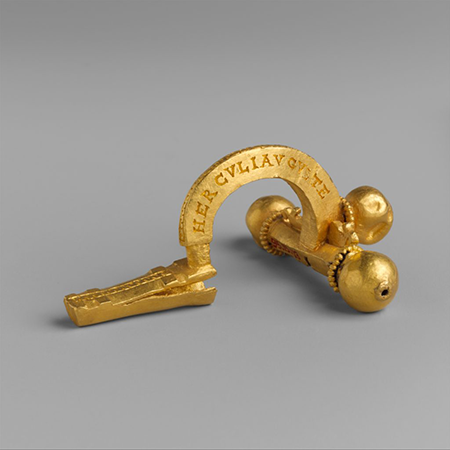
The fibula, a functional yet decorative brooch, stands as a testament to ancient innovation, artistry, and cultural diversity. Evolving from simple garment fasteners to ornate status symbols, fibulae reflect the technological advancements, artistic tastes, and social hierarchies of the societies that used them.
Status Symbols: Elaborate fibulae made from gold or decorated with gemstones indicated wealth and power.
Military Use: Roman soldiers used specific types of fibulae to fasten their cloaks, with certain designs associated with rank or unit identity.
Regional Identity: Designs varied across the empire, reflecting local artistic influences and cultural traditions.
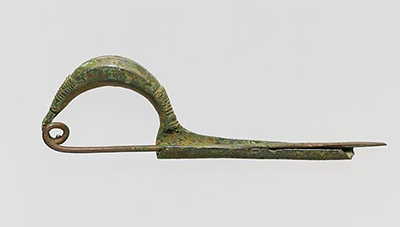
Features: A simple arch with a pin secured in a catch plate.
Variations: Some designs were plain and functional, while others featured detailed engravings, gilding, or decorative knobs.
Distribution: Found throughout the empire, especially in military contexts, as they were durable and practical for everyday wear.
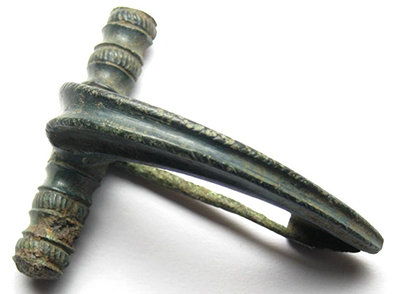
Features: A smooth, curved body with a wide, rounded head and a tapering tail.
Popularity: Common in Mediterranean regions, the dolphin fibula reflects Roman artistic appreciation for natural forms.
Decoration: Often adorned with simple grooves or inlaid enamel.
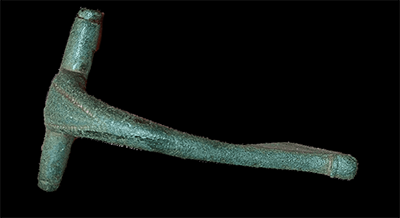
T-Fibula
The T-shaped fibula emerged as a practical and stylish option during the early Roman period.
Features: A horizontal crossbar (forming the "T") with a sturdy pin mechanism.
Function: Particularly favored by Roman soldiers for fastening heavy cloaks.
Regional Use: Widely found in Roman frontier regions, such as Britain and the Rhineland.
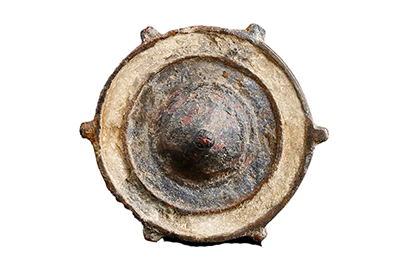
Plate / Disc Fibulae
Plate / Disc fibulae were large, flat brooches often used for decorative purposes
Features: A broad, flat surface that could be intricately engraved or enameled.
Cultural Significance: Frequently adorned with symbols or motifs, such as animals, mythological figures, or geometric patterns.
Materials: Bronze and silver were commonly used, with gold reserved for high-status individuals.
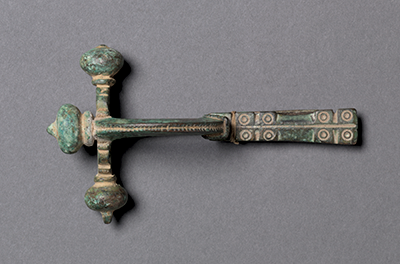
Crossbow Fibula
The crossbow fibula, named for its resemblance to a crossbow, became prominent in the late Roman Empire (3rd–4th centuries CE).
Features: A horizontal bar with decorative knobs at each end.
Usage: Commonly worn by military officers and civil servants, often signifying rank.
Materials: Elaborate examples featured gold or silver, while simpler versions were made from bronze.
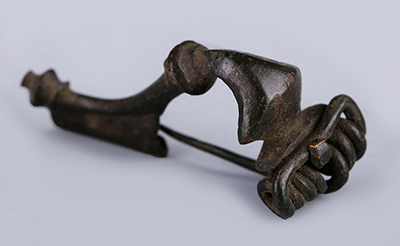
Knee Fibula
The knee fibula is a unique design characterized by a sharp bend that resembles a human knee
Features: A sharply angled body and a robust pin mechanism.
Usage: Designed for colder climates, where thick fabrics required stronger fasteners.
Regional Popularity: Found predominantly in northern provinces of the Roman Empire.
Archaeological Significance of Fibulae
Fibulae are among the most common finds at Roman archaeological sites, offering valuable insights into ancient life. Their materials, designs, and distribution help historians understand:
Fibulae are among the most common finds at Roman archaeological sites, offering valuable insights into ancient life. Their materials, designs, and distribution help historians understand:
Trade Networks: The spread of specific styles reflects trade and cultural exchange within the empire.
Social Structures: Elaborate fibulae indicate wealth and status, while simpler designs reflect everyday use.
Technological Advances: Innovations in metalworking, such as casting and enameling, are evident in fibula craftsmanship.
Conclusion
The fibula, particularly during the Roman era, represents a remarkable blend of functionality, artistry, and cultural significance. From simple pins to elaborate status symbols, these brooches tell the story of an empire that was as diverse as it was innovative.
The fibula, particularly during the Roman era, represents a remarkable blend of functionality, artistry, and cultural significance. From simple pins to elaborate status symbols, these brooches tell the story of an empire that was as diverse as it was innovative.
Today, Roman fibulae remain a source of fascination for detectorists, archaeologists, historians, and collectors, serving as tangible links to a world that valued both practicality and beauty in everyday objects. As timeless artifacts, they continue to shed light on the complexity and richness of Roman civilization.


